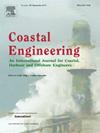Experimental and numerical investigation of the dynamic response of coastal box-girder superstructures considering rotational effects under extreme wave loading
IF 4.5
2区 工程技术
Q1 ENGINEERING, CIVIL
引用次数: 0
Abstract
Due to the rising frequency of extreme marine disasters, research on the interaction between coastal bridges and waves has gained significant attention in recent years. Bridge superstructures are typically subjected to rotation or even overturning failure under extreme wave conditions. However, existing experimental studies have scarcely accounted for these effects under extreme wave conditions. Thus, a steel rotating shaft system was employed in this study to implement the rotational effects of the superstructure. Subsequently, the influence of bridge piers and adjacent structures was considered, followed by a series of fluid-structure interaction experiments and numerical simulations to more accurately investigate the wave forces and dynamic response of the rotatable box-girder superstructure (BGSS) under extreme wave conditions. Moreover, a comparison of existing wave force calculation formulas was conducted, and an empirical formula for predicting the wave forces on the BGSS, incorporating the rotational effects under extreme wave loadings, was proposed. The results demonstrate that accounting for the rotational effects of the BGSS enables a more realistic and accurate representation of the dynamic response of the superstructure under practical conditions. Furthermore, a reduction in the wave period or the submersion coefficient of the superstructure leads to an increase in the inclination and wave forces acting on the BGSS. The empirical formula proposed in this study is capable of accurately predicting the wave forces acting on the BGSS, considering rotational effects, when subjected to extreme waves.
考虑旋转效应的沿海箱梁上部结构在极端波浪荷载下动力响应的试验与数值研究
近年来,由于极端海洋灾害的频繁发生,沿海桥梁与海浪相互作用的研究受到了广泛关注。桥梁上部结构在极端波浪条件下通常会发生旋转甚至倾覆破坏。然而,现有的实验研究几乎没有考虑到极端波浪条件下的这些影响。因此,本研究采用钢转轴系统来实现上部结构的旋转效应。随后,考虑桥墩和相邻结构的影响,并进行一系列流固耦合试验和数值模拟,以更准确地研究极端波浪条件下可旋转箱梁上部结构(BGSS)的波浪力和动力响应。并对现有波浪力计算公式进行了比较,提出了考虑极端波浪荷载作用下旋转效应的波浪力预测经验公式。结果表明,考虑到BGSS的旋转效应,可以更真实、更准确地表示上部结构在实际条件下的动力响应。此外,波浪周期的减小或上部结构的淹没系数的减小会导致作用在BGSS上的倾斜和波浪力的增加。本研究提出的经验公式能够在考虑旋转效应的情况下,准确预测作用在BGSS上的波浪力。
本文章由计算机程序翻译,如有差异,请以英文原文为准。
求助全文
约1分钟内获得全文
求助全文
来源期刊

Coastal Engineering
工程技术-工程:大洋
CiteScore
9.20
自引率
13.60%
发文量
0
审稿时长
3.5 months
期刊介绍:
Coastal Engineering is an international medium for coastal engineers and scientists. Combining practical applications with modern technological and scientific approaches, such as mathematical and numerical modelling, laboratory and field observations and experiments, it publishes fundamental studies as well as case studies on the following aspects of coastal, harbour and offshore engineering: waves, currents and sediment transport; coastal, estuarine and offshore morphology; technical and functional design of coastal and harbour structures; morphological and environmental impact of coastal, harbour and offshore structures.
 求助内容:
求助内容: 应助结果提醒方式:
应助结果提醒方式:


